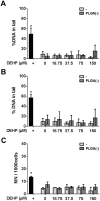Vectorization by nanoparticles decreases the overall toxicity of airborne pollutants
- PMID: 28813539
- PMCID: PMC5557588
- DOI: 10.1371/journal.pone.0183243
Vectorization by nanoparticles decreases the overall toxicity of airborne pollutants
Abstract
Atmospheric pollution is mainly composed of volatile pollutants and particulate matter that strongly interact. However, their specific roles in the induction of cellular toxicity, in particular the impact of the vectorization of atmospheric pollutants by ultrafine particles, remains to be fully elucidated. For this purpose, non-toxic poly-lactic co-glycolic acid (PLGA) nanoparticles were synthesized and three pollutants (benzo(a)pyrene, naphthalene and di-ethyl-hexyl-phthalate) were adsorbed on the surface of the nanoparticles in order to evaluate the toxicity (cytotoxicity, genotoxicity and ROS induction) of these complexes to a human airway epithelial cell line. The adsorption of the pollutants onto the nanoparticles was confirmed by HPLC analysis. Interestingly, the cytotoxicity assays (MTT, LDH and CellTox Green) clearly demonstrated that the vectorization by nanoparticles decreases the toxicity of the adsorbed pollutants. Genotoxicity was assessed by the micronucleus test and the comet assay and showed no increase in primary DNA damage or in chromosomal aberrations of nanoparticle vectorized pollutants. Neither cytotoxicity nor genotoxicity was correlated with ROS induction. To conclude, our results indicate that the vectorization of pollutants by nanoparticles does not potentiate the toxicity of the pollutants studied and that, on the contrary, adsorption onto nanoparticles could protect cells against pollutants' toxicity.
Conflict of interest statement
Figures










References
-
- Ris C. U.S. EPA health assessment for diesel engine exhaust: a review. Inhalation toxicology. 2007;19 Suppl 1:229–39. doi: 10.1080/08958370701497960 - DOI - PubMed
-
- Westerdahl D, Fruin S, Sax T, Fine PM, Sioutas C. Mobile platform measurements of ultrafine particles and associated pollutant concentrations on freeways and residential streets in Los Angeles. Atmospheric Environment. 2005;39(20):3597–610. http://dx.doi.org/10.1016/j.atmosenv.2005.02.034. - DOI
-
- Sioutas C, Delfino RJ, Singh M. Exposure assessment for atmospheric ultrafine particles (UFPs) and implications in epidemiologic research. Environmental health perspectives. 2005;113(8):947–55. doi: 10.1289/ehp.7939 . - DOI - PMC - PubMed
-
- Valavanidis A, Fiotakis K, Vlachogianni T. Airborne particulate matter and human health: toxicological assessment and importance of size and composition of particles for oxidative damage and carcinogenic mechanisms. Journal of environmental science and health Part C, Environmental carcinogenesis & ecotoxicology reviews. 2008;26(4):339–62. doi: 10.1080/10590500802494538 - DOI - PubMed
MeSH terms
Substances
LinkOut - more resources
Full Text Sources
Other Literature Sources

